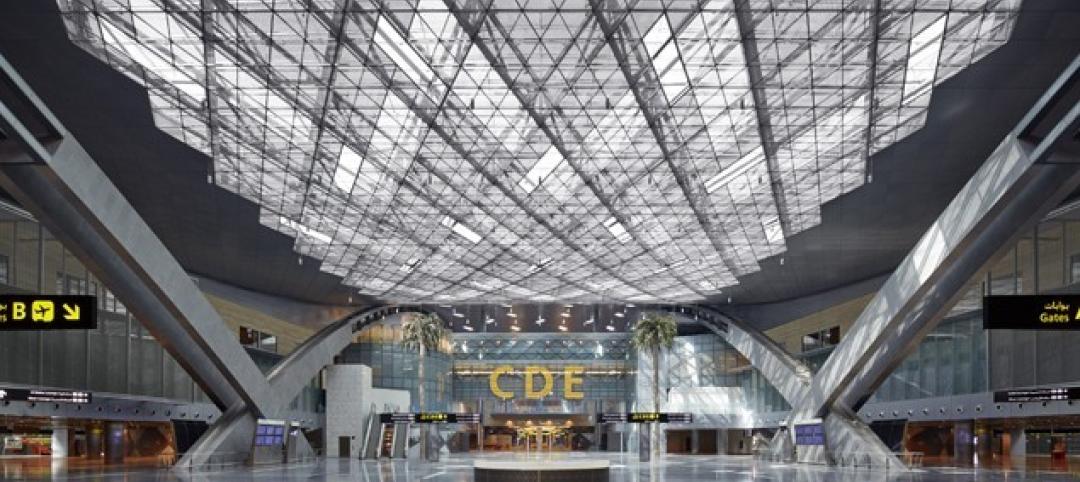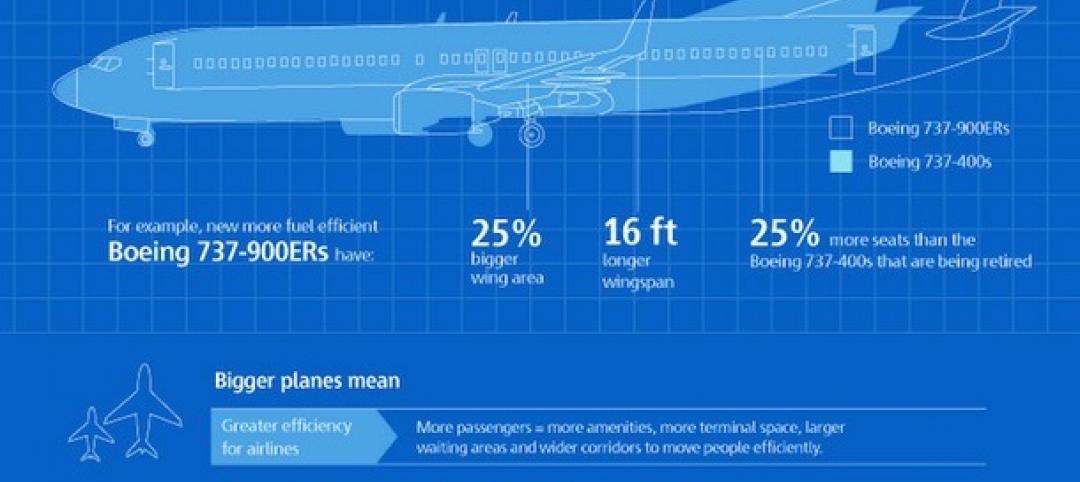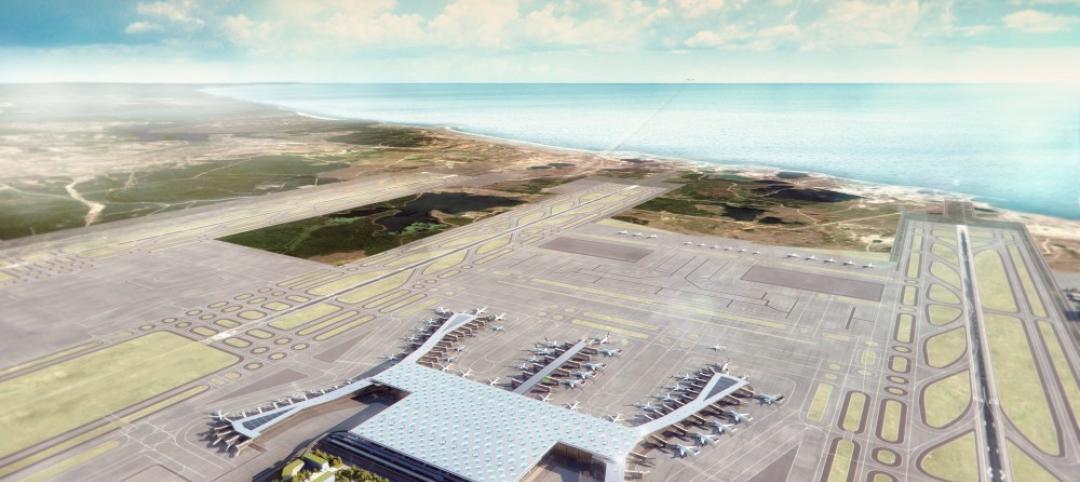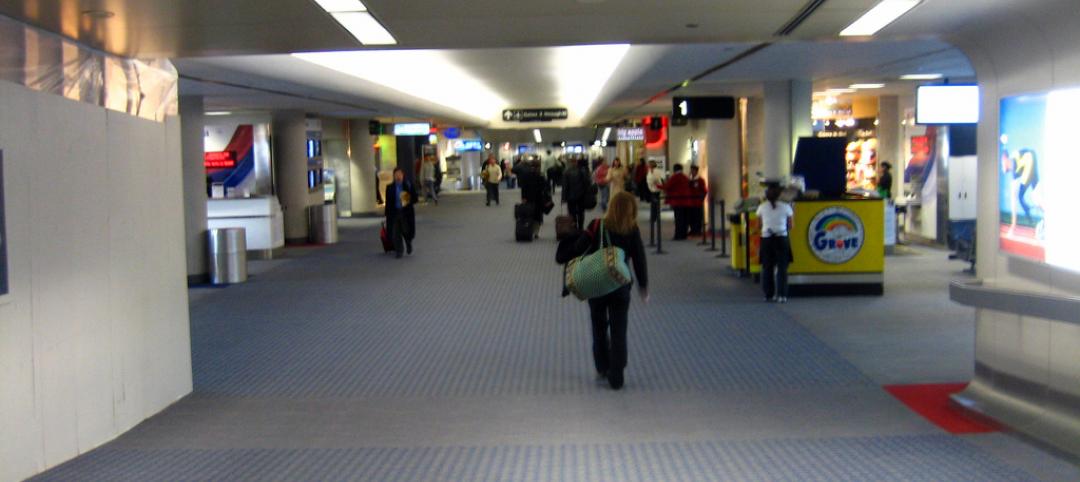In June, the Dwight D. Eisenhower National Airport in Wichita, Kan., opened a new 275,000-sf, 12-gate terminal. According to an airport press release, the new facility “expresses …Wichita’s globally prominent position in Aviation as the Air Capital of the World.” The $200 million-plus terminal (which includes a new consolidated rental car facility) can handle two million passengers annually. It was designed (by HTNB) to support future growth up to 2.4 million.
Passenger traffic at the airport (formerly known as Wichita Mid-Continent Airport) was about 1.5 million in 2014, up 6% from the previous year. As of mid-2015, it is running about even with last year, says Victor White, Wichita Airport Authority’s Director of Airports.
Regional airports like Eisenhower National—which offers flights to and from Atlanta, Chicago, Dallas, Denver, Houston, Las Vegas, Los Angeles, Minneapolis-St. Paul, and Phoenix—are doing everything they can to hold onto business. But small-to-midsize airports are still battling for their lives, as big carriers are cut or eliminate service to non-hub cities.
A 2013 report from Massachusetts Institute of Technology’s International Center for Air Transportation found that small- and medium-sized airports ”have been disproportionally affected by reductions in service,” with medium-sized airports having felt “the biggest brunt” of airline network strategies.
This report predicts that smaller airports close to major hubs could be at risk of losing all of their carrier service by 2018. That’s bad news for local municipalities that see their airports as economic engines.
San Luis Obispo County (Calif.) Regional Airport is a case in point. In 2008 Delta ceased service to Salt Lake City, U.S. Air discontinued flights to Las Vegas, and American Airlines pulled out of the airport altogether. About 60% of travelers in this region now fly out of Los Angeles or the San Francisco Bay Area, according to The Tribune, a newspaper that covers this market.
County officials believe San Luis Obispo’s prosperity hinges on its airport’s growth. Despite ongoing discussions with several carriers, the airport has had trouble finding airlines willing to provide service to Dallas, Salt Lake, or Denver.
White says that over the past decade, Wichita’s airport has managed to grow through aggressive marketing and airline recruitment. Four of the nation’s largest carriers—American, Delta, United, and Southwest—all fly out of Eisenhower, as does Allegiant Air, which caters to leisure travelers.
Wichita’s airport was also one of the first to offer incentives to carriers in the form of guaranteeing revenue and other subsidies, a practice that is now common among small and medium size airports. “Southwest Airlines wouldn’t have come here if we hadn’t provided guarantees and subsidies,” White says.
Rent income from airlines is one of the revenue streams that Wichita tapped to pay for its new terminal, along with user fees, commissions on retail sales, and a $4.50 per passenger facility fee. It also received a $60 million FAA grant, and another $7 million from TSA, says White.
The MIT report noted that while airlines have been grounding their older, smaller turbo planes and moving to larger jets with more seats, they still aren’t offering small and midsize airports enough flights to match demand.
At Eisenhower, White says that carriers are mostly flying Airbus or Boeing jets. But, he’s quick to add, demand continues to outpace availability. “The biggest complaint that passengers have is that flights are too full and it is hard to find a seat at the time and price they want to fly.”
Related Stories
BIM and Information Technology | Dec 28, 2014
The Big Data revolution: How data-driven design is transforming project planning
There are literally hundreds of applications for deep analytics in planning and design projects, not to mention the many benefits for construction teams, building owners, and facility managers. We profile some early successful applications.
| Dec 28, 2014
AIA course: Enhancing interior comfort while improving overall building efficacy
Providing more comfortable conditions to building occupants has become a top priority in today’s interior designs. This course is worth 1.0 AIA LU/HSW.
| Dec 28, 2014
The future of airport terminal design: destination status, five-star amenities, stress-free travel
Taking a cue from the hospitality industry, airport executives are seeking to make their facilities feel more like destinations, writes HOK's Richard Gammon.
| Dec 15, 2014
HOK-designed Anaheim Regional transit hub opens, expected to serve three million per year
ARTIC’s flexible design ensures that it can serve as a southern terminus for California’s future high-speed rail system.
| Dec 8, 2014
Moshe Safdie wants to reinvent airports with Jewel Changi Airport addition
A new addition to Singapore's Changi Airport, designed by Moshe Safdie, will feature a waterfall and extensive indoor gardens.
| Nov 19, 2014
The evolution of airport design and construction [infographic]
Safety, consumer demand, and the new economics of flight are three of the major factors shaping how airlines and airport officials are approaching the need for upgrades and renovations, writes Skanska USA's MacAdam Glinn.
| Nov 18, 2014
Grimshaw releases newest designs for world’s largest airport
The airport is expected to serve 90 million passengers a year on the opening of the first phase, and more than 150 million annually after project completion in 2018.
| Nov 14, 2014
JetBlue opens Gensler-designed International Concourse at JFK
The 175,000-sf extension includes the conversion of three existing gates to international swing gates, and the addition of three new international swing gates.
Sponsored | | Nov 12, 2014
Eye-popping façade highlights renovation, addition at Chaffin Junior High School
The new distinctive main entrance accentuates the public face of the school with an aluminum tube “baguette” system.
| Oct 26, 2014
New York initiates design competition for upgrading LaGuardia, Kennedy airports
New York Gov. Andrew Cuomo said that the state would open design competitions to fix and upgrade New York City’s aging airports. But financing construction is still unsettled.

















